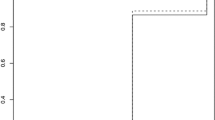Abstract
The existing literature on savings, insurance, and portfolio choices under risk has revealed that quite often comparative statics results depend, among other things, upon the values of the coefficients of relative risk aversion and relative prudence. More specifically the benchmark values for these coefficients are, respectively, one and two. Recently, several papers investigated constraints on the higher degree extensions of the coefficients of relative risk aversion and of relative prudence. The present work provides a unified approach to this question based on the concept of elementary correlation increasing transformations, allowing for a better understanding of changes in risk in the multiplicative case.
Similar content being viewed by others
References
Caballe, J., & Pomansky, A. (1996). Mixed risk aversion. Journal of Economic Theory, 71, 485–513.
Chiu, W. H., Eeckhoudt, L., & Rey, B. (2012). On relative and partial risk attitudes: Theory and implications. Economic Theory, 50, 151–167.
Eeckhoudt, L., Etner, J., & Schroyen, F. (2009). The values of relative risk aversion and prudence: A context-free interpretation. Mathematical Social Sciences, 58, 1–7.
Eeckhoudt, L., & Hammitt, J. (2001). Background risks and the value of a statistical life. Journal of Risk and Uncertainty, 23, 261–279.
Eeckhoudt, L., & Rey, B. (2011). Risk vulnerability: A graphical interpretation. Theory and Decision, 71, 227–234.
Eeckhoudt, L., & Schlesinger, H. (2006). Putting risk in its proper place. American Economic Review, 96, 280–289.
Eeckhoudt, L., & Schlesinger, H. (2008). Changes in risk and the demand for saving. Journal of Monetary Economics, 55, 1329–1336.
Ekern, S. (1980). Increasing \(n\)th degree risk. Economics Letters, 6, 329–333.
Epstein, L. G., & Tanny, S. M. (1980). Increasing generalized correlation: A definition and some economic consequences. Canadian Journal of Economics, 13, 16–34.
Franke, G., Schlesinger, H., & Stapleton, R. (2006). Multiplicative background risk. Management Science, 52, 146–153.
Gollier, C. (2001). The economics of risk and time. Cambridge, MA: MIT Press.
Gollier, C. (2010). Discounting, inequalities and economic convergence. Toulouse: Mimeo, Toulouse School of Economics.
Gollier, C., & Pratt, J. W. (1996). Risk vulnerability and the tempering effect of background risk. Econometrica, 64, 1109–1124.
Ingersoll, J. (1987). Theory of financial decision making. New Brunswick, NJ: Rowman & Littlefield.
Jones-Lee, M. (1974). The value of changes in the probability of death or injury. Journal of Political Economy, 76, 553–568.
Menezes, C., Geiss, C., & Tressler, J. (1980). Increasing downside risk. American Economic Review, 70, 921–932.
Menezes, C. F., & Hanson, D. L. (1970). On the theory of risk aversion. International Economic Review, 11, 481–487.
Meyer, D., & Meyer, J. (2005). Relative risk aversion: What do we know? Journal of Risk and Uncertainty, 31, 243–262.
Rothschild, M., & Stiglitz, J. (1970). Increasing risk: I. A definition. Journal of Economic Theory, 2, 225–243.
Tchen, A. H. (1980). Inequalities for distributions with given marginals. Annals of Probability, 8, 814–827.
Wang, J., & Li, J. (2010). Multiplicative risk apportionment. Mathematical Social Sciences, 60, 79–81.
White, L. (2008). Prudence in bargaining: The effect of uncertainty on bargaining outcomes. Games and Economic Behavior, 62, 211–231.
Zeckhauser, R., & Keeler, E. (1970). Another type of risk aversion. Econometrica, 38, 661–665.
Acknowledgments
The authors would like to express their gratitude to anonymous referees and an associate editor whose comments have been extremely useful to revise a previous version of the present work. The financial support of PARC “Stochastic Modelling of Dependence” 2012–2017 awarded by the Communauté française de Belgique is gratefully acknowledged by Michel Denuit.
Author information
Authors and Affiliations
Corresponding author
Rights and permissions
About this article
Cite this article
Denuit, M., Rey, B. Benchmark values for higher order coefficients of relative risk aversion. Theory Decis 76, 81–94 (2014). https://doi.org/10.1007/s11238-013-9353-8
Published:
Issue Date:
DOI: https://doi.org/10.1007/s11238-013-9353-8
Keywords
- Expected utility
- Higher order relative risk aversion
- Higher order multiplicative risk apportionment
- Wealth effect
- Stochastic dominance




